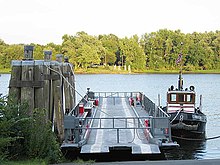Rocky Hill-Glastonbury Ferry

The Hollister III (barge) and the Cumberland (tow boat)
|
|
| Waterway | Connecticut River |
|---|---|
| Transit type | towboat and barge |
| Route |
|
| Carries | pedestrians, bicycles, automobiles |
| Terminals |
Rocky Hill (41°39′59″N 72°37′47″W / 41.666363°N 72.629648°WCoordinates: 41°39′59″N 72°37′47″W / 41.666363°N 72.629648°W) to Glastonbury (41°39′56″N 72°37′36″W / 41.66565°N 72.626537°W) |
| Operator | Connecticut State Ferry Service |
| Authority | Connecticut Department of Transportation (ConnDOT) |
| Began operation | 1655 |
| Frequency | as needed |
| No. of vessels | Cumberland tows Hollister III |
| Daily ridership | 400 |
The Rocky Hill–Glastonbury ferry is a seasonal ferry crossing the Connecticut River between the towns of Glastonbury and Rocky Hill, Connecticut and is part of Route 160. It is believed to be the oldest continuously operated ferry service in the United States. The river crossing has an annual average daily traffic of 400.
The ferry is the oldest continuously running ferry service in the United States. Started in 1655, it actually began before the foundation of the towns of Glastonbury and Rocky Hill, both towns being part of Wethersfield at that time.
Originally a raft that was poled across the Connecticut River, it was then powered by a horse on a treadmill before being upgraded to a steamship in 1876. Today's ferry is a 3-car barge named the Hollister III towed by a diesel towboat named the Cumberland.
The ferry landings and the ferry itself are included in the Glastonbury–Rocky Hill Ferry Historic District, which was listed on the National Register of Historic Places in 2005. The National Register listing was proposed in 2005 to help preserve the historic ferry. The historic district also encompasses farmscapes of the Great Meadows in South Glastonbury that preserve 17th-century land use patterns and Colonial and Greek Revival farmhouses, as well as the homes of shipbuilders and merchant traders near the two landings, including several examples of Colonial and Italianate architecture.
...
Wikipedia
